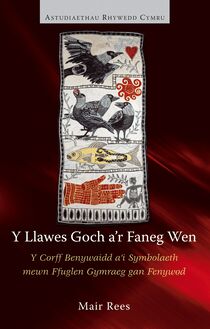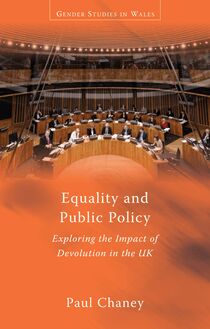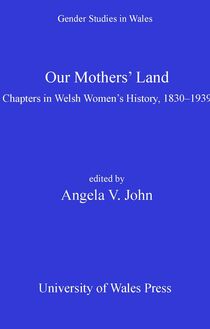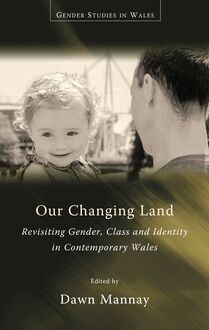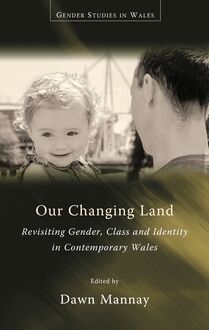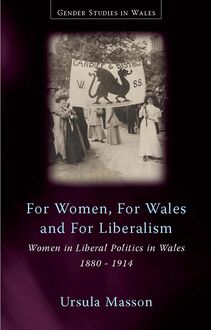Nineteenth-Century Women's Writing in Wales , livre ebook
148
pages
English
Ebooks
2010
Vous pourrez modifier la taille du texte de cet ouvrage
Obtenez un accès à la bibliothèque pour le consulter en ligne En savoir plus
Découvre YouScribe en t'inscrivant gratuitement
Découvre YouScribe en t'inscrivant gratuitement
148
pages
English
Ebooks
2010
Vous pourrez modifier la taille du texte de cet ouvrage
Obtenez un accès à la bibliothèque pour le consulter en ligne En savoir plus
Publié par
Date de parution
15 février 2010
Nombre de lectures
1
EAN13
9781783163953
Langue
English
Winner of the Roland Mathias Award 2009. This book argues that the way in which people came to perceive and to represent themselves as Welsh was profoundly affected by the gender ideologies prevalent during the Romantic and Victorian periods. Nineteenth-Century Women s Writing in Wales: Nation, Gender and Identity introduces readers to a hundred Welsh women authors at work during the years 1780-1900, some writing in Welsh and some in English. In so doing, it rescues many of these authors from critical neglect and oblivion. In the second half of the nineteenth century in particular, Welsh women writers in both languages were numerous and enjoyed a degree of influence on Welsh culture easily commensurate with that of women writers today. By covering the nineteenth century chronologically, this book traces the coming into being of the Welsh nation as its women in particular saw it, and as they helped to create it.
Publié par
Date de parution
15 février 2010
Nombre de lectures
1
EAN13
9781783163953
Langue
English
NINETEENTH-CENTURY WOMEN S WRITING IN WALES
Gender Studies in Wales Astudiaethau Rhywedd yng Nghymru
Series Editors Jane Aaron, University of Glamorgan Brec hed Piette, Bangor University Sian Rhiannon Williams, University of Wales Institute Cardiff
Series Advisory Board Deirdre Beddoe, Emeritus Professor Mihangel Morgan, Aberystwyth University Teresa Rees, Cardiff University
The aim of this series is to fill a current gap in knowledge. As a number of historians, sociologists and literary critics have for some time been pointing out, there is a dearth of published research on the characteristics and effects of gender difference in Wales, both as it affected lives in the past and as it continues to shape present-day experience. Socially constructed concepts of masculine and feminine difference influence every aspect of individuals lives; experiences in employment, in education, in culture and politics, as well as in personal relationships, are all shaped by them. Ethnic identities are also gendered; a country s history affects its concepts of gender difference so that what is seen as appropriately masculine or feminine varies within different cultures. What is needed in the Welsh context is more detailed research on the ways in which gender difference has operated and continues to operate within Welsh societies. Accordingly, this interdisciplinary and bilingual series of volumes on Gender Studies in Wales, authored by academics who are leaders in their particular fields of study, is designed to explore the diverse aspects of male and female identities in Wales, past and present. The series is bilingual, in the sense that some of its intended volumes will be in Welsh and some in English.
NINETEENTH-CENTURY WOMEN S WRITING IN WALES
NATION, GENDER AND IDENTITY
Jane Aaron
Jane Aaron, 2007 Cover image: Cover illustration: Hon (one in a series of forty), mixed media on Khadi paper, 75x55cms. Iwan Bala 2004 (private collection).
First edition published in 2007 Second edition published in 2010
All rights reserved. No part of this book may be reproduced in any material form (including photocopying or storing it in any medium by electronic means and whether or not transiently or incidentally to some other use of this publication) without the written permission of the copyright owner except in accordance with the provisions of the Copyright, Designs and Patents Act 1988 or under the terms of a licence issued by the Copyright Licensing Agency Ltd, Saffron House, 6-10 Kirby Street, London, EC1N 8TS. Applications for the copyright owner s written permission to reproduce any part of this publication should be addressed to The University of Wales Press, 10 Columbus Walk, Brigantine Place, Cardiff, CF10 4UP.
www.uwp.co.uk
British Library Cataloguing-in-Publication Data A catalogue record for this book is available from the British Library.
ISBN 978-0-7083-2277-2 e-ISBN 978-1-78316-395-3
The right of Jane Aaron to be identified as author of this work has been asserted by her in accordance with sections 77, 78 and 79 of the Copyright, Designs and Patents Act 1988.
i JTK
Acknowledgements
I am indebted to a number of individuals and institutions for their help with this book. The two main debts I have incurred are to John Koch and Diana Wallace, who read through the whole manuscript with meticulous care and made a great many useful suggestions for amendments; I am very grateful to them both. I should also like to thank the many friends and colleagues who discussed aspects of the book with me and spurred me on, in particular Deirdre Beddoe, Catherine Brennan, Catherine Charnell-White, Claire Flay, Katie Gramich, E. Wyn James, Ursula Masson, Sarah Prescott, Rosanne Reeves, and my two Gender Studies in Wales co-editors, Brec hed Piette and Sian Rhiannon Williams.
As for institutions, the volume could not have been completed without the aid of an Arts and Humanities Research Council grant which bought a respite from teaching duties, and I should also like to thank the University of Glamorgan for providing sabbatical relief. And without the help of the staff of the National Library of Wales, in particular Huw Walters, it would not have been what it is; the opportunity they afforded me of browsing in the library s stacks led to the inclusion within these pages of many authors whom I would not otherwise have discovered. My debt is great also to the staff of the University of Wales Press, particularly Sarah Lewis, for their enthusiastic support not only of this book but also of the series of which it forms a part.
The book owes its origins to my earlier Welsh-language volume on the image of the Welsh woman in nineteenth-century women s writing, Pur fel y Dur: Y Gymraes yn Ll n Menywod y Bedwaredd Ganrif ar Bymtheg , but it is not a translation of it. This present study covers the century with greater thoroughness, and includes twice the number of authors discussed in the previous work. In the struggle to encompass all the material, and because of the difficulties of introducing to an English-language audience texts not available in translation, I have in some cases limited the discussion of the Welsh-language writers included here: readers interested in the hymn writers, for example, will find more extensive analyses of their work in Pur fel y Dur .
Though they have since been much revised, parts of this book have also appeared in the following publications: Women s Writing , 1 (1994); Re-visioning Romanticism: British Women Writers, 1776-1837 , edited by Carol Shiner Wilson and Joel Hafner (Philadelphia: University of Pennsylvania Press, 1994); Welsh Writing in English: A Yearbook of Critical Essays , 1 (1995); Feminisms on Edge: Politics, Discourses and National Identities edited by Karen Atkinson, Sarah Oerton and Gill Plain (Cardiff: Cardiff Academic Press, 2000); and A Tolerant Nation? Exploring Ethnic Diversity in Wales , edited by Charlotte Williams, Neil Evans and Paul O Leary (Cardiff: University of Wales Press, 2003). All of this material is used here by permission of the publishers.
Contents
Acknowledgements
Prologue
1. Romantic Wales
2. Writing Ancient Britain
3. Becoming National
4. Rebels and Reactionaries
5. Developing Women s Welsh-language Print Culture
6. Writing Young Wales
Epilogue
Notes
Selected Bibliography
Prologue
In 1804 Catherine Davies (1773-1841) of Beaumaris in Anglesey took up a post in Paris as nurse to the children of Caroline Murat, sister of Napoleon Bonaparte. Her nationality soon became a problem; the children grew attached to her but their uncle requested that she be dismissed: he apparently told his sister, women could correspond as well as men , that is, the new nurse might act as a spy. 1 She was instructed to hide herself during his visits, but her continuing presence in the household was on one occasion inadvertently disclosed to him:
It happened one morning, as the emperor was walking in the gardens with his sister, the children espied them from one of the windows of the palace, and called out to the emperor, Oh, uncle! He looked up, and saw me; upon which he said, Ah, you English there! I replied, Yes, Sire.
[P]resently they both entered the apartment where we were. The emperor said to me, You English are not good. I replied, Sire, there are some of the English good, and some bad, as well as the French. Do you , he asked, like the French as well as the English? Sire , I replied, if I were to say I liked the French as well as the English, I should think myself a hypocrite; but I like those of all nations who are kind to me. His majesty tapped me on the shoulder, and said, Bravo! Bravo! I like you, because you are so candid. 2
For all her candour it clearly did not occur to Catherine Davies in 1804 to reassure Napoleon by telling him that she was not in fact English. And yet a later passage from her memoir Eleven Years Residence in the Family of Murat, King of Naples (1841) makes it apparent that she felt no lack of attachment to her actual native country. After Napoleon had crowned his sister and her husband, Joachim Murat, king and queen of Naples in 1808, and Davies had moved with their household to that city, she was invited along with the family to visit a British naval vessel which had entered the bay during a temporary cessation of hostilities. While exploring the English man-of-war , as she terms it, she noticed a young midshipman,
who followed us closely, and who from time to time looked at me with fixed attention. At length he approached me, and asked if I were not a native of Wales. Surprised at the question, I replied in the affirmative. Pleasure beamed in his countenance. I too, said he, was born in Wales ; and he proceeded to say that his father was a clergyman living in Caermarthen [ sic ]. We became from this moment intimate friends. 3
Catherine Davies identifies herself as a native of Wales and feels an immediate intimacy with a fellow countryman; she must also, presumably, have retained a Welsh accent, for the sailor to discover their shared Welshness so quickly. Nevertheless, she would appear to have no sense of herself as having a national identity other than that of the nation-state under whose rule she was reared, and to which she gives the title England . After undergoing with the Murats the downfall of their reign in Naples, including a sustained bombardment by the British fleet and her own arrest by the British on suspicion of being a spy for the ex-queen, Catherine Davies returned to Beaumaris: Here, in my native spot, she says, I have remained ever since. 4 But even after twenty years back home in Wales she could not, when she came to write her memoirs, identify herself in national terms as anything other than English , though her intimate bonds and sense of belonging are with the Welsh. The lack of connection in her account between her natal and her national identity is indicative of that confusion to which Raymond Willi

